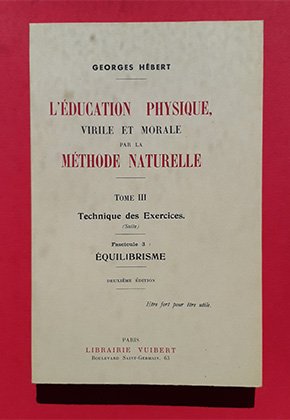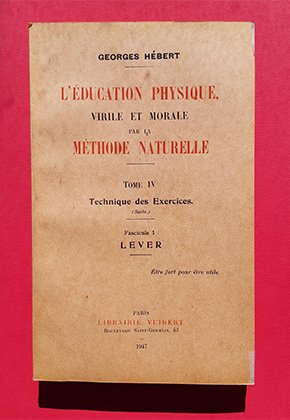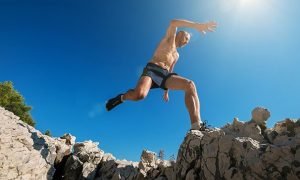Criteria Mesurement Rating
Today, the comfort of a gym seems to be able to provide what it takes to maintain physical shape and acquire strength. The practitioner of a sporting discipline is considered “athlete” and the winner of such and such a discipline acquires the title of athlete.
But faced with the need to react to an unforeseen obstacle, or to move quickly or for a long time, on uneven ground or strewn with pitfalls, to climb in balance to flee a danger or cross an obstacle… physical fitness, cold blood , energy, responsiveness won’t they be lacking for fans of rooms or landscaped grounds?
Strength cannot be reduced to a musculature cultivated with the weight of the body or dumbbells, to a performance acquired in a particular field or to a victory gained against an opponent. Its definition is more complex.
To be strong means to have a general ability to respond physically and mentally to material or moral obstacles or trials and not a particular faculty in a specific area.
Georges Hébert, in his book “The Code of Force”, defined the different elements that constitute force, in the purely physical domain, as below:
1° The strength criteria
1° Resistance and endurance |
 Endurance and resistance, also called “background”, are the ability to produce an effort of any kind, or to withstand fatigue for a prolonged period.
Endurance and resistance, also called “background”, are the ability to produce an effort of any kind, or to withstand fatigue for a prolonged period.
This element of force essentially depends on the functioning value of the internal organs and more particularly:
- Of the heart,
- And lungs.
It is the natural consequence of regular and methodical training and above all of sustained effort in general and travel in particular.
It also depends on a healthy life without excess and is intimately linked to the state of health. It is the essential quality of strength.
2° Muscle power |
 Muscular power is the ability to perform sufficient efforts in all directions with the different parts of the body (pulling, pushing, lifting, climbing, throwing, carrying, defending oneself, etc.).
Muscular power is the ability to perform sufficient efforts in all directions with the different parts of the body (pulling, pushing, lifting, climbing, throwing, carrying, defending oneself, etc.).
It depends not only on the degree of development of the muscles but also on the nervous excitation which is communicated to them by the will, that is to say by the power of the nervous system.
3° Speed |

Speed is the ability to move quickly or to perform quick movements, quick releases, quick starts, etc.
It depends not only on the sensitivity of the nervous system and its power, but also on the quality of the muscles and the flexibility of the joints.
Thin, long muscles, typical of natural development, are more conducive to brisk movement than large, short muscles.
4° Adress |

Dexterity is the ability to use one’s muscles and skills to achieve a specific result.
It saves energy and delays the onset of fatigue.
Nervous mastery is the first condition of skill. To execute a precise gesture, it is already necessary to conceive cerebrally, then to transmit nervously to finally execute muscularly (which will also depend on joint flexibility).
In the event of poor nerve transmission, the gesture will have a much lower degree of precision. A skill throw or a balance will be successful not by muscular capacity, but simply by the perfect coordination between the conception of the right gesture, the necessary power, direction etc.
5° Qualities of actions |

The qualities of actions are qualities such as energy, will, courage, composure, glance, decision, firmness or tenacity. Or even confidence in one’s own worth to overcome one’s fears, mastery of vertigo or resistance to pain.
If the purely “physical” dimension is a key aspect of strength, the part of the psychic or mental factor is an essential value: a gifted subject who is well trained but who lacks energy or courage is helpless in the face of obstacles or trials. .
6° Technique |
 The “technique” is the knowledge of the procedures for carrying out the essential natural and utilitarian exercises, and at the same time, a sufficient degree of aptitude in each of them (walking, running, jumping, climbing, quadrupedalism, balance, throwing, lift-carry, defense and swimming).
The “technique” is the knowledge of the procedures for carrying out the essential natural and utilitarian exercises, and at the same time, a sufficient degree of aptitude in each of them (walking, running, jumping, climbing, quadrupedalism, balance, throwing, lift-carry, defense and swimming).
7° “Organic” stamina |

This is the body’s endurance to different attacks. Resistance to cold, heat, bad weather, pain are part of the general resistance mentioned above.
More generally, it is the body’s ability to maintain health in all circumstances, to resist, as best as possible, diseases, deprivations, microbes, viruses…
Finally, it should be considered that force can, unfortunately, serve good as well as evil. Also to all these “physical” qualities must be added a quality of another order, ethical, in order to direct all this acquired towards a higher good, in a useful, fair and benevolent way.
As specified in the doctrine, true strength or a true education is a synthesis that Georges Hébert synthesized as follows:
« La vraie force réside non pas seulement dans les muscles, le souffle, l’adresse…
mais avant tout, dans l’énergie qui l’utilise, la volonté qui la dirige ou le sentiment qui la guide. »
“True strength lies not only in the muscles, the breath, the address…
but above all, in the energy which uses it, the will which directs it or the feeling which guides it. »
Georges Hébert – La Méthode naturelle – Tome 1
2° The measure of strength
After having defined the extent of the force, it is a question of questioning the way of measuring the latter.
If it is relatively easy to measure the level of a subject in mathematics or English, what about its complexity, strength?
How can we also measure its evolution, or compare two people with each other?
 |
 |
Une comparaison parlante : Lequel est le plus fort ? La réponse n’a rien d’ évident… |
|
Strength measurement allows everyone to get to know each other better and gives coaches a valuable tool for comparing and monitoring progress. It also makes it possible to quickly discover the weak points and to direct the training accordingly to overcome them.
It could be done, for example:
By simply taking measurements (arm or calf circumference, etc.) and comparing them to pre-established scales in order to be able to deduce a level.
Or by the recording of parameters, by all kinds of instruments, to measure the respiratory capacity, the power of the heart, or the strength of the arms or legs etc…
However, these measurements will never give precise indications of the value of the force, in the Hébertist sense of the word. From a practical and utilitarian point of view, there is only one way to determine with certainty the real value of a person, and that is to see the latter actually performing concrete exercises and to have the means of “grading” their performance.
The 12 measurable tests with rated performance
It is a question of determining a series of tests which synthesize and make it possible to best measure the different qualities and that, moreover, the performances are easily measurable and reproducible both in time and in space.
Twelve tests were selected:
- 3 races: 1 sprint, 1 middle distance, 1 long distance
- 4 jumps: high and long, each with and without momentum
- 1 climb
- 1 rise
- 1 throw
- And 2 swimming events: distance and diving
3° The quotation of the tests

The tests are scored in points, in an original and easily understandable way, according to a scale established as follows:
The rating “zero” (0) characterizes the basic level that a person must be able to achieve.
This “median” rating serves as a toggle, like a scale, between:
- insufficient performance (which will then be negative, and in theory without a lower limit)
- and higher performance (which will then be positive and in theory without upper limit!).

|
Fitness level symbolized by a thermometer |
The basic level is obviously variable according to age in order to be able to be adapted to each one and to make it possible to evaluate the progressions, or regressions, in particular in children, adolescents etc…
This level also varies according to gender. If, in young children, it is substantially the same in girls and boys, a differentiation that must be taken into account appears in preadolescence around 11-13 years.
Example of fiche pour un moniteur, to know the value of people he would have to train.



















